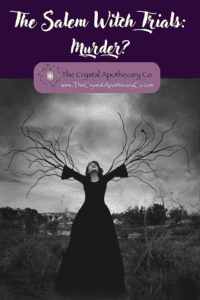
Murder at The Salem Witch Trials?
Murder at the Salem Witch Trials?
Murder at the Salem Witch Trials?
There are many theories surrounding the Salem Witch Trials. One theory suggests that the trials began because of a lack of communication between the colony and England. Another theory says that the trials were due to the fact that there was no single leader of the colony. Still others say that the trials were due solely to religious zealots.
The most common explanation given for the Salem Witch Trials is that they were sparked by a combination of religious zealotry, fear and superstition, according to History.com. The Puritans believed that God could use anyone to punish those who did evil things.
They also feared that Satan was trying to take over the world. These fears combined with the belief that some people were possessed by demons led to the persecution of innocent people.
In 1692, the Massachusetts Colony passed a law making witchcraft punishable by death. This law was later repealed. However, the trials continued into 1693. During the trial, 19 people were hanged. Others were imprisoned for life. Some of the accused were tortured.
Witch hunts
In early modern Europe, there are many cases of people accused for witchcraft and put to death for it. These witch trials were often based on hearsay evidence and most of those accused did not receive a proper trial. This article looks into how witches were perceived in medieval society and how they were treated during the witch hunts.
A witch hunt began after the 1692 Salem Witch Trials. People would accuse others without clear evidence. They would even accuse themselves and others just to avoid being blamed for something else. Cotton Mather wrote a letter to the court asking them to stop using spectral evidence, which he called “superstitious.” Increase Mather spoke out against the use of spectral testimony.
Governor William Phips outlawed the practice of witchcraft trails after the trials had ended. He believed it was a waste of public money.
Setting the scene
The Putnam family was involved with the witchcraft trials of 1692. They had a large influence on those events. Their efforts to seize power in the Salem church resulted in the Salem Witch Trials. The Putnam’s influenced the Salem Witch Trials. We’ll explore the history of the Putnam family, including what happened to John Putnam Sr., his son Samuel, and grandson Thomas Putnam Jr..
Salem Struggling
In 1692, the English government declared war against France. This led to the start of the French and Indian War. After three years, the British won the war. However, it wasn’t over yet. The conflict dragged on for another eight years.
The French and Indians had been fighting the British since the early 1600s. They weren’t very successful. But then, in 1691, the French and Indians attacked the town of Yorktown, Virginia. The British lost control of New York City. And in 1692, the English declared war against France. The war lasted for five years.
During those five years, people were afraid of being accused of witchcraft. There were many accusations, especially during the Salem Witch Trials.
People believed in witches until the late 1800s.
Three witches of the Salem witch trials
Three witches are accused of witchcraft in Salem, Massachusetts in 1692.
The three women are Elizabeth Proctor, Abigail Williams, and Ann Putnam Jr. They are charged with being “witches.” However, no one knows why they are being charged.
Elizabeth Proctor and her husband John Proctor are both hanged. Their daughter Sarah Good is sentenced to life imprisonment. Her son John Hathorne is appointed the judge during the trial.
Abigail Williams and Mary Warren are tried together. Both are found guilty and hang.
Ann Putnam Jr. is arrested after accusing another woman, Tituba, of being a witch. She is tortured into confessing.
In 1711, Thomas Hutchinson writes about the trials in his book A History of the Colony of Massachusetts Bay. He says that there were many witnesses who testified against the women, but he does not say whether those witnesses were called to testify.
He also says that some of the accusers admitted that they had been paid to make up stories. During the trials themselves, there were many theatrical events that took place on part of the young accusers. Many were coerced or peer-pressured into saying they saw these innocent people practicing witchcraft which led to their deaths or imprisonment. Many of the women who were accused of witchcraft were pregnant as well!
HISTORY of What Really Happened at The Salem Witch Trials?
In 1692, over 200 women and men were arrested in Salem, Massachusetts, and charged with witchcraft. They were tortured and killed during the trials. Historians now believe that the hysteria began shortly after an outbreak of bubonics plague in Boston.
The accused women were physically examined for signs of demonic possession. They were also questioned about their involvement with Satan. Many of them confessed to having practiced witchcraft. Some of them recanted later. Others died while awaiting trial.
The judges decided whether the accused should be put to death based on the evidence presented during the trial.
There are many reasons why people might have been accused of witchcraft. For example, they may have refused to give up their property to pay off debts. Or they may have had disagreements with neighbors over land ownership.
The witch hunt lasted nearly three decades, and it wasn’t until 1711 that the last person was executed. Today, there are still places where you can see evidence of the torture of those accused of being witches.
The accused women were held in prison until trial. They were then tried before a jury of 12 men and 6 women. If convicted, they were hanged or burned at the stake.
The first recorded witch hunt occurred in 1584 when a group of people in Essex County, England, accused several people of witchcraft. This led to the execution of two people.
In 1645, Massachusetts Bay Colony passed an act requiring all persons suspected of practicing witchcraft to be brought before magistrates for examination. Those found guilty were executed.
In 1648, New Haven Colony passed a law making witchcraft punishable by death.
In 1653, Connecticut passed a similar law.
In 1664, Rhode Island passed a law making witchcraft a capital offense.
In 1692, King William’s War ended with the surrender of most of the English colonies in North America. During this time, many Indians began accusing colonists of witchcraft.
In 1697, Pennsylvania enacted a law making witchcraft a felony punishable by hanging.
In 1698, Maryland made witchcraft a capital crime.
In 1712, Virginia enacted a law making witchcraft punishable as a misdemeanor.
In 1715, South Carolina made witchcraft a capital crime, but did not enact a statute punishing those accused of witchcraft.
In 1718, Georgia made witchcraft a capital crime; however, the penalty was commuted to life imprisonment.
In 1722, North Carolina made witchcraft a capital offense. However, the law was repealed in 1727.
In 1736, Delaware made witchcraft a capital crime and enacted a statute punishing those accused.
In 1741, New York made witchcraft a capital crime if committed on someone else.
In 1742, New Jersey made witchcraft a capital crime for the first time.
In 1743, Pennsylvania made witchcraft a capital crime again.
In 1744, New Hampshire made witchcraft a capital crime only if committed against another person.
In 1746, Maine made witchcraft a capital crime (but without a statute).
In 1747, Maryland made witchcraft a misdemeanor.
In 1803, Vermont made witchcraft a misdemeanor.

BLACK RUTILE TOURMALINE CRYSTAL TOWERS
Restoring Good Names
The Salem Witch Trials are often referred to as one of the most famous events in American history. During the mid 1600s, hundreds of people were accused of being witches and hanged. Some historians say that the Salem Witch Trials were caused by mass hysteria caused by ergot poisoning. Ergotism is a disease caused by mold growing on rye bread. People who ate infected bread became violently ill.
They believed that it was the devil causing this illness. This belief led to many people being arrested and tried for witchcraft.
A memorial was built in honor those who died during the trial. The Peabody Essex museum houses the original court documents. These documents show how much evidence there was against the accused.
There were no confessions recorded during the trials. However, there were several testimonies given by witnesses who saw the accused doing things considered to be witchcraft. For example, they could see the accused turning into a black dog and flying through the air.
In the 16th century, witchcraft trials began in Germany, Britain, France, and other European countries. Many people accused of witchcraft had their tongues cut out. Others were hung, drawn, and quartered. Most of these executions took place in public. Women were especially targeted because they were thought to be more likely to practice witchcraft. In fact, a lot of women who were suspected of practicing witchcraft were burned alive.
One woman named Agnes Marshall was burned alive in 1593. She was accused of having sex with Satan.
Many people think that the Salem Witch Trials are just another story about superstition gone awry. But the truth is, the Salem Witch Trials were real. And they still happen today. Do you believe in witches and witchcraft?
Looking to cleanse after all this negativity? Try some black tourmaline here!
Want to read further about witches and the witch hunt at the Salem witch trials? Check this out.






